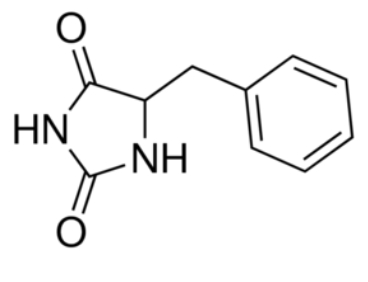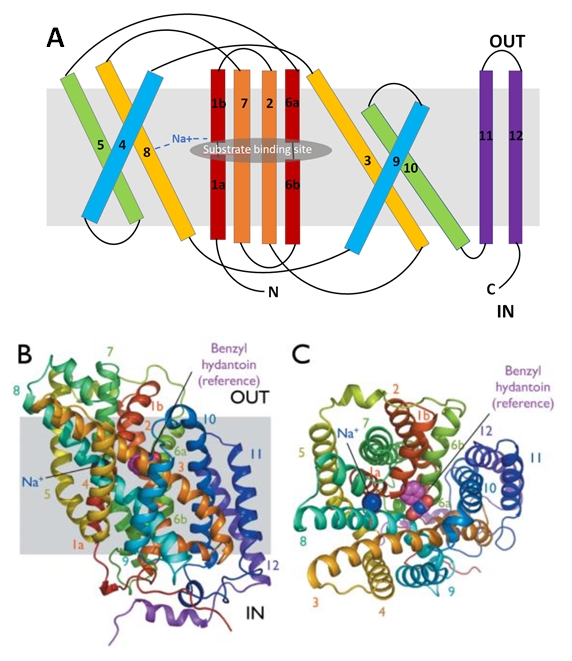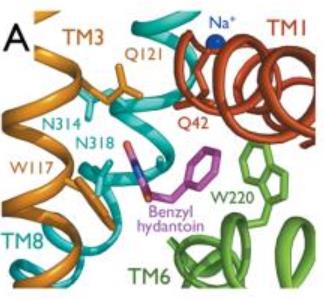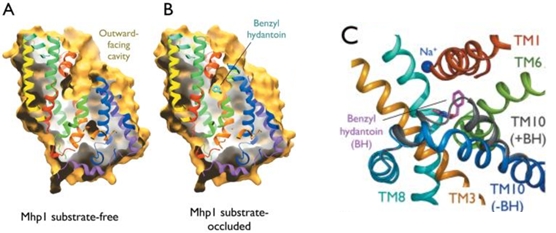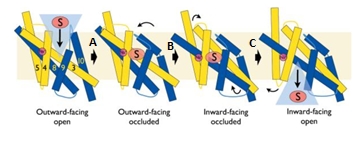Sandbox Reserved 1489
From Proteopedia
(Difference between revisions)
| Line 17: | Line 17: | ||
== '''Structural highlights''' == | == '''Structural highlights''' == | ||
| - | == Global structure == | + | ===Global structure=== |
The protein is composed of one chain of 12 transmembrane alpha helices (TMs). They are organised in two repeating units connected by a 59-residue loop (TMs 1-5 and TMs 6-10) and two additional helices (TM 11 and 12). The two repeating units have a symmetrical topology (''Figure 2''). | The protein is composed of one chain of 12 transmembrane alpha helices (TMs). They are organised in two repeating units connected by a 59-residue loop (TMs 1-5 and TMs 6-10) and two additional helices (TM 11 and 12). The two repeating units have a symmetrical topology (''Figure 2''). | ||
| Line 31: | Line 31: | ||
| - | == Structure of the substrate binding site == | + | ===Structure of the substrate binding site=== |
The substrate binding site is located at the break of the TMs 1 and 6. | The substrate binding site is located at the break of the TMs 1 and 6. | ||
| Line 42: | Line 42: | ||
| - | == Structure of the cation binding site == | + | ===Structure of the cation binding site=== |
Mhp1 is a sodium dependent protein. The sodium binds at the C-terminal end of TM1a and interacts with TM8 (''Figure 2.A''). The dipole moment at the C-terminus of TM1a contributes to the binding. | Mhp1 is a sodium dependent protein. The sodium binds at the C-terminal end of TM1a and interacts with TM8 (''Figure 2.A''). The dipole moment at the C-terminus of TM1a contributes to the binding. | ||
Revision as of 18:18, 9 January 2019
| This Sandbox is Reserved from 06/12/2018, through 30/06/2019 for use in the course "Structural Biology" taught by Bruno Kieffer at the University of Strasbourg, ESBS. This reservation includes Sandbox Reserved 1480 through Sandbox Reserved 1543. |
To get started:
More help: Help:Editing |
2JLN
| |||||||||||
References
- ↑ Hanson, R. M., Prilusky, J., Renjian, Z., Nakane, T. and Sussman, J. L. (2013), JSmol and the Next-Generation Web-Based Representation of 3D Molecular Structure as Applied to Proteopedia. Isr. J. Chem., 53:207-216. doi:http://dx.doi.org/10.1002/ijch.201300024
- ↑ Herraez A. Biomolecules in the computer: Jmol to the rescue. Biochem Mol Biol Educ. 2006 Jul;34(4):255-61. doi: 10.1002/bmb.2006.494034042644. PMID:21638687 doi:10.1002/bmb.2006.494034042644
